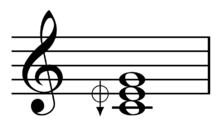15 equal temperament


In music, 15 equal temperament, called 15-TET, 15-EDO, or 15-ET, is a tempered scale derived by dividing the octave into 15 equal steps (equal frequency ratios). Each step represents a frequency ratio of 15√2, or 80 cents (![]()
History and use
Guitars have been constructed for 15-ET tuning. The American musician Wendy Carlos used 15-ET as one of two scales in the track Afterlife from the album Tales of Heaven and Hell.[3] Easley Blackwood, Jr. has written and recorded a suite for 15-ET guitar.[4] Blackwood believes that 15 equal temperament, "is likely to bring about a considerable enrichment of both classical and popular repertoire in a variety of styles".[5]
Interval size
Here are the sizes of some common intervals in 15-ET:
| interval name | size (steps) | size (cents) | midi | just ratio | just (cents) | midi | error |
|---|---|---|---|---|---|---|---|
| perfect fifth | 9 | 720 | 3:2 | 701.96 | +18.04 | ||
| septimal tritone | 7 | 560 | 7:5 | 582.51 | −22.51 | ||
| 11:8 wide fourth | 7 | 560 | 11:8 | 551.32 | +8.68 | ||
| 15:11 wide fourth | 7 | 560 | 15:11 | 536.95 | +23.05 | ||
| perfect fourth | 6 | 480 | 4:3 | 498.04 | −18.04 | ||
| septimal major third | 5 | 400 | 9:7 | 435.08 | −35.08 | ||
| undecimal major third | 5 | 400 | 14:11 | 417.51 | −17.51 | ||
| major third | 5 | 400 | 5:4 | 386.31 | +13.69 | ||
| minor third | 4 | 320 | 6:5 | 315.64 | +4.36 | ||
| septimal minor third | 3 | 240 | 7:6 | 266.87 | −26.87 | ||
| septimal whole tone | 3 | 240 | 8:7 | 231.17 | +8.83 | ||
| major tone | 3 | 240 | 9:8 | 203.91 | +36.09 | ||
| minor tone | 2 | 160 | 10:9 | 182.40 | −22.40 | ||
| greater undecimal neutral second | 2 | 160 | 11:10 | 165.00 | −5.00 | ||
| lesser undecimal neutral second | 2 | 160 | 12:11 | 150.63 | +9.36 | ||
| just diatonic semitone | 1 | 80 | 16:15 | 111.73 | −31.73 | ||
| septimal chromatic semitone | 1 | 80 | 21:20 | 84.46 | −4.47 | ||
| just chromatic semitone | 1 | 80 | 25:24 | 70.67 | +9.33 | ||
15-ET matches the 7th and 11th harmonics well, but only matches the 3rd and 5th harmonics roughly. The perfect fifth is more out of tune than in 12-ET, 19-ET, or 22-ET, and the major third in 15-ET is the same as the major third in 12-ET, but the other intervals matched are more in tune. 15-ET is the smallest tuning that matches the 11th harmonic at all and still has a usable perfect fifth, but its match to intervals utilizing the 11th harmonic is poorer than 22-ET, which also has more in-tune fifths and major thirds.
Although it contains a perfect fifth as well as major and minor thirds, the remainder of the harmonic and melodic language of 15-ET is quite different from 12-ET, and thus 15-ET could be described as xenharmonic. Unlike 12-ET and 19-ET, 15-ET matches the 11:8 and 16:11 ratios. 15-ET also has a neutral second and septimal whole tone. To construct a major third in 15-ET, one must stack two intervals of different sizes, whereas one can divide both the minor third and perfect fourth into two equal intervals.
References
- ↑ Myles Leigh Skinner (2007). Toward a Quarter-tone Syntax: Analyses of Selected Works by Blackwood, Haba, Ives, and Wyschnegradsky, p.52. ISBN 9780542998478.
- ↑ Skinner (2007), p.58n11. Cites Cohn, Richard (1997). "Neo-Riemannian Operations, Parsimonious Trichords, and Their Tonnetz Representations", Journal of Music Theory 41/1.
- ↑ David J. Benson, Music: A Mathematical Offering, Cambridge University Press, (2006), p. 385. ISBN 9780521853873.
- ↑ Easley Blackwood, Jeffrey Kust, Easley Blackwood: Microtonal, Cedille (1996) ASIN: B0000018Z8.
- ↑ Skinner (2007), p.75.

